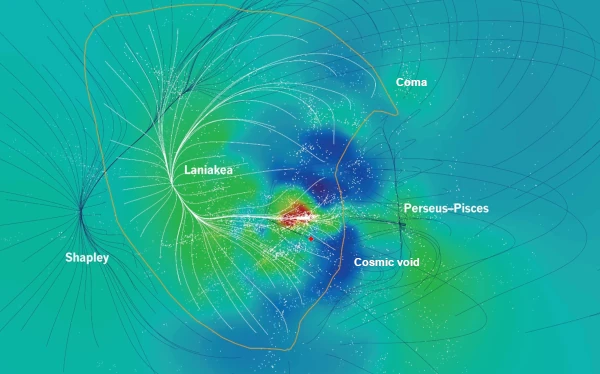
Image description: This supercluster called Laniakea is not only one of the largest known structures in the universe, it is ours (pale orange outline). Galaxies are represented by small white dots, while white lines show the movement of galaxies towards the center of the supercluster. The small red circle indicates the location of the Milky Way within the supercluster. Image credit: R. Brent Tully (U. Hawaii) et al., DP / CEA / Saclay, France.
Discovered in 2014 thanks to the work of Brent Tully and his team, Laniakea, which means "immense sky" in Hawaiian, is the galactic supercluster to which our Milky Way belongs. This supercluster contains about 100,000 galaxies spread over a distance of 520 million light-years and has an estimated total mass of 10¹⁷ solar masses. This vast ensemble is held together by gravitational forces that organize galaxies into a complex network of filaments and voids, connecting the large structures of the observable universe.
Laniakea is defined by gravitational flows that converge towards a central point called the Great Attractor. These flows indicate the direction in which galaxies are attracted under the influence of gravity. Thanks to observations of the distribution of galaxies and radial velocities, it is possible to map the boundaries of Laniakea and understand how structures form on a large scale in the universe.
The identification of Laniakea has redefined our perception of our position in the universe. While our Milky Way seems isolated at first glance, it is actually connected to a much larger cosmic network. This discovery also highlights the importance of gravitational interactions in the formation and evolution of galactic structures.
Approximate distance: About 650 million light-years.
Characteristics: One of the most massive superclusters in the local universe, located in the direction of the Centaurus constellation, rich in bright galaxies.
Approximate distance: About 320 million light-years.
Characteristics: Located near the constellation Coma Berenices, it contains well-defined galaxy clusters such as Abell 1656.
Approximate distance: About 300 million light-years.
Characteristics: It is part of the densest regions of the local universe and is centered on the Coma group of galaxies, a concentration of thousands of galaxies.
Approximate distance: About 150 to 200 million light-years.
Characteristics: Shares a gravitational connection with Laniakea and contains several rich clusters such as Abell 3526.
Approximate distance: About 220 million light-years.
Characteristics: Located in the southern region of the sky near the constellations Pavo and Indus, with a compact structure and several rich clusters.
Approximate distance: About 250 million light-years.
Characteristics: One of the longest filaments of galaxies in the local universe, connecting several galaxy clusters.
These superclusters, although physically distinct, sometimes interact gravitationally with each other on a cosmic scale. This makes the universe a vast dynamic web where gravitational forces shape the distribution of galaxies.
The exact number of superclusters contained in the observable universe is difficult to determine precisely, as it depends on the exact definition of what is called a supercluster, as well as the limits of current observations. However, estimates can be made by combining cosmological data, the distribution of galaxies, and theoretical models.
Size of the observable universe: Radius = approximately 46.5 billion light-years.
Volume: About 4π/3 × (46.5 billion)³, or approximately 3.5 × 10⁸⁰ m³.
Typical superclusters have a size of 100 to 500 million light-years and contain on the order of 10⁴ to 10⁵ galaxies.
Considering the size and average spacing of superclusters (a few hundred million light-years between them), it can be estimated that there are approximately 10 million superclusters in the observable universe.
These superclusters, although physically distinct, interact gravitationally with each other on a cosmic scale. This makes the universe a vast dynamic web where gravitational forces shape the distribution of galaxies.